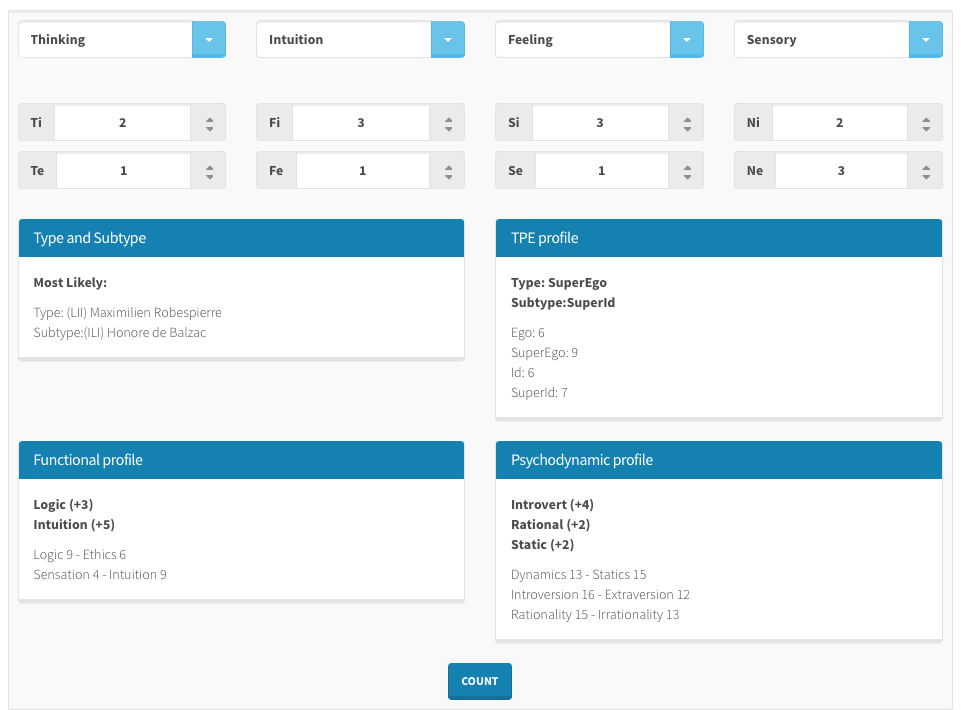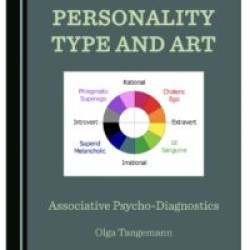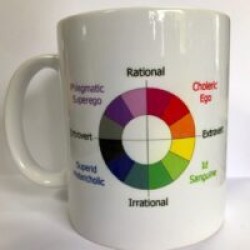I have developed an online questionnaire for the personality type diagnostics where I suggest the client to record their answers on video. The questionnaire is based on a client-centred approach – the client’s functional self-analysis. In working with a client I rely on functional preference calculations and help him or her to look objectively at their preferences, to realize contradictions in their perception of typological attributes.
Key words: socionics, questionnaire, analysis, diagnosis, personality type, function, dichotomy, profile, type of psychic energy, small groups, model A
My approach to the identification of a personality type can be compared to the “client-centered” approach of C. Rogers:
“Psychologist, according to Rogers, should focus on the subjective or phenomenological, experience of his client. Rogers believed that a person has a tendency to self-actualization, which promotes the health and growth. The psychologist works as an assistant in removing emotional blocks or obstacles to growth and contributes to greater client’s maturity (with the elimination of obstacles to the growth of the forces are released and opens the way for self-development and self-improvement) “(2).
Questionnaire can be used for the remote diagnostics as well as for on-site interviews. (1) The client has to record their answers on video that gives consultant a valuable factual and illustrative material for analysis and conclusions about the client’s type. An important feature of this approach is a quantitative analysis of the client’s self-evaluation, which allows the consultant to objectively identify and make evident to the client contradictions in the judgment of his personality type.
Inconsistencies in the self-perception is a big problem not only for the client, but also for a consultant. It is very important for the client to evaluate himself and prioritize the functions since at this stage begins the process of forming an opinion about the type for some and re-evaluation of the existing type for others. For the elimination of any doubts about the type the person need to put in order his thoughts about himself and his typological attributes.
The objective analysis made on the client’s functional preferences greatly facilitate the work of the consultant as he can refer to the clients own opinion. In contrast to the traditional approach the client is perceived as an active participant in the process, who is equally responsible for the decision on his personality type. The clearer and more consistent, he judges himself and brings substantial amount of the facts about his typical behaviour and thoughts, the easier it is for the consultant to determine the client’s personality type.
The practitioner’s task is to help the client to realize his type by intensifying his thought process. This attitude towards the client is ethical in nature, as the client will have to take the final decision about his type himself based on the analysis of the information he has provided. Consultant weighs the available information and summarizes the most probable version of personality type and subtype. It is important not so much the point of view of a consultant, as the work of the mind and soul of a client because the whole experience is is self- enlightening for many people as the way to your true self.
At the beginning of the questionnaire the client is asked to answer the questions of a more general attitude in order for the consultant to get to know the client and make the first impression about his personal strengths and weaknesses. Next, the client is invited to identify their strengths and weaknesses from the descriptions of 4 functions (logics, ethics, sensory, and intuition) on the criteria “mine, not mine, not sure”.
The client is offered to place the function in order from strongest to weakest, e.g. Logics(3) – Intuition(2) – Ethics(1) – Sensory(0).
The first two positions in the functional profile are considered to be strong, while two subsequent positions are relatively weak (neutral) and very weak.
In the second part of the questionnaire the client is invited to evaluate not just 4 but 8 function in the same way: “mine, not mine, not sure.”
In the “mine” category any function is defined as strong and is assigned a score of 3.
In the “not mine” category a function is defined as weak and is assigned a score of 1.
In the “not sure” category function is defined as neutral and is assigned a score of 2.
For example:
1. My functions: Fi3, Ne3, Si3
2. Not sure: Ti2, Ni2
3. Not my functions: Se1,Te1, Fe1
On the basis of data received consultant makes calculations using calculator.

In calculating the functional profile of the client the prinсiple on blocking functions in model A should be considered as highly relevant. Particular importance is attached to the comparison of the functions in the mental and vital blocks Model A. In theory of associative socionics there is a concept that the functions of the mental block are stronger than the functions in the vital block, because of greater awareness and more frequent use. (5) If static functions ( Ti, Fi, Se, Ne) have larger values compared to dynamic functions ( Te, Fe, Si, Ni) then in the mental block of the model A must be static functions and the type is a static one. It also means that the type of the person belongs to one of the static TPEs: Id or Superego.
This principle is considered to be one of the basic criteria in associative of psycho-diagnostics (APD) both verbal and non-verbal preferences. The theory of functional dimensions by A. Bukalov is not applicable because functional dimensions do not depend on the position of the functions in relation to mental or vital blocks. (6)
As I have noted earlier, in the model A functions are divided between mental and vital blocks based on the dichotomy statics- dynamics, which contradicts the model G of Victor Gulenko. In his model G, functions are grouped in the vital- and mental blocks on the grounds of introversion-extraversion. (7)
An objective analysis of the personality type and subtype is based on calculations of the functional profile and the TPE profile by the clients functional preferences. The function values assigned to TPE groups, and also to mental and vital blocks of model A are all taken into account. This checklist is used in APD in conjunction with the assessment of non-verbal preferences and opinion of the client about his type. (8)
Literature:
1. Tangemann O.B. Questionnaire [Electron. resource]. – Access mode:
http://socionics4you.com/post-1854?lang=en
2. Osipova A.A .Client-centered approach of Carl Rogers. General psychological correction. Tutorial. – M .: Sfera, 2002 – 510 p. [Electron. resource]. Access: http://psylist.net/psytera/00135.htm
3. Tangemann O.B. The associative model. “Psychology and Socionics of Interpersonal Relationships.” 2009, N1, p. 38 – 52.
4. Bukalov A.V. On the dimension of information metabolism functions. [Electron. resource]. – Access mode: http://socionic.info/pdf/as-p203.pdf
5. Gulenko V.V. Socionic model (energomodel). [Electron. resource]. – Access: http://uchoniyartist.blogspot.co.uk/2012/12/blog-post_18.html
6.Tangemann O.B Criteria for assessing preferences in art through the prism of the typology. – [Electronic. resource]. Access mode: http://socionics4you.com/post-5867?lang=en











